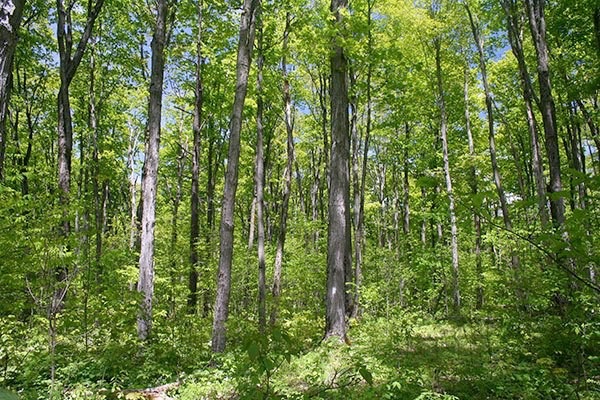Clarke Birchard
Many of the following features can be found in smaller, younger deciduous woodlots. In an old growth forest they will be in greater abundance and more widespread.
TALL OLD TREES
The old growth eastern deciduous forest is not like the temperate rain forests of the west coast or the tropical and sub-tropical forest of the equatorial zone. Do not look for trees with huge trunks that take 5 people to join hands around. Look instead at how far it is up to the first branch of some of the Kinghurst old maples.
UNDULATING FOREST FLOOR (PITS AND MOUNDS MICRO-TOPOGRAPHY)
Pits and mounds are formed when large trees that may have been standing dead for many years are uprooted. Pits occur where the roots and soil clinging to them once were. Roots and the logs decay to form mounds. A variety of habitats are created for many forms of life. When many forests were cleared and the land cultivated pits and mounds were leveled.
WOODY (ORGANIC) LITTER ON THE FOREST FLOOR
Dead and decaying logs, branches and leaves cover the forest floor enriching the soil with nutrients and providing habitat for many forms of life. This layer also acts as a sponge retaining moisture. Mushrooms, bracket fungi, mosses and microscopic forms of life are recycling the woody debris.
RICH AND VARIED GROUND COVER
The ground is covered with a rich variety of wildflowers, ferns, mosses, fungi, bacteria and seedlings of trees and shrubs. Many plants occur in large colonies that have had years and years to grow and spread undisturbed.
SHRUBS, SAPLINGS AND UNDERSTORY TREES (VERTICAL STRATIFICATION)
Groundcover plants, shrubs and saplings grow in the shade of mature canopy trees. Some may be almost as old as the trees above them, held back by competition for light, moisture and nutrients.
CANOPY CLOSED OR ALMOST CLOSED
The tops of mature trees form a continuous ceiling that shades the layers below.
REGENERATION BY CANOPY GAPS
Occasionally canopy trees fall down due to death and old age, wind, damage by insects, beaver or other causes. This creates gaps in the canopy allowing in the sunshine and rain and releasing nutrients for other forms of life. Regeneration and succession begin again in these openings. Even a so-called old growth forest is constantly evolving, constantly reinventing itself.
SUPER CANOPY TREES
If the top of an old growth forest could be seen from above it would seem to be almost level. Trees growing in lower areas are taller while trees on the tops of knolls and hills are shorter resulting in an almost level canopy. A few tall pines poke through the canopy providing landmarks, nesting sites for hawks and owls, perching and lookout sites.
CAVITY TREES
Living or dead trees with holes can be used for nesting, denning, feeding and shelter. Some holes are created by decay where branches have broken off; some are created by birds (e.g. woodpeck- ers). Secondary cavity users (e.g. flying squirrels) take over and sometimes modify existing cavities.
SNAGS
Snags are standing dead trees which provide habitat for owls, woodpeckers, flycatchers, warblers, tree swallows, bats, squirrels, ants, termites, beetles and numerous other forms of life. Think of them as the tall apartment buildings of the forest.
“AN OLD GROWTH FOREST IS NOT JUST A COLLECTION OF TREES FROZEN IN TIME LIKE A PHOTOGRAPH. IT CONTAINS A HISTORY OF WHAT CAME BEFORE AND THE POTENTIAL OF WHAT IS TO COME.” Henry and Quinby
NOTE: Southern Ontario is understood to be that portion of Ontario south of the Pre-Cambrian Shield. The above discussion of forest genesis and types applies to upland tolerant hardwoods. Other forest types such as Eastern White Cedar function and change quite differently.
REFERENCES
Stabb, Mark. Southern Ontario Woodlands: Introducing Old Growth The Ultimate Forest. Federation of Ontario Naturalists.
Larson, Brendon M. et al. The Woodland Heritage of Southern Ontario. The Federation of Ontario Naturalists. 1999.
Kettle, Andrea (ed.). Southern Ontario Woodlands – The Conservation Challenge. The Federation of Ontario Naturalists. 1999.
MNR. The Old-growth Forests of Southern Ontario. Extension Note No. LRC 26. 1996. Queen’s Printer for Ontario.
MNR Restoring Old-growth Features to Managed Forests in Southern Ontario. Extension Note No. LRC 27. 1996. Queen’s Printer for Ontario.
Henry, Michael and Peter Quinby. Ontario’s Old Growth Forests. Fitzhenry and Whiteside. 2010.

Photo credit: Joe Crowley


